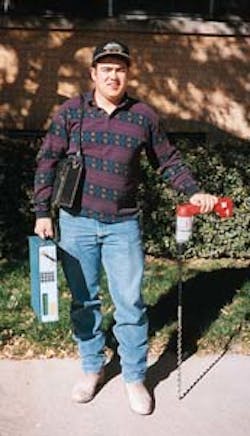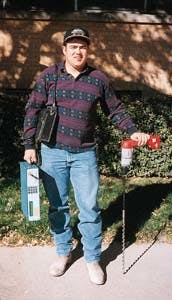BTEX detector's results good in oil identification
Gerry G. Calhoun
New Paradigm Exploration Inc.
NashvilleJames Hawkins
New Paradigm Exploration Inc.
Midland, Tex.
The junior author with the MSI-301, used for detecting benzene, toluene, ethylbenzene, and xylene concentrations in soil gas (Fig. 2).Single-ring aromatic compounds, the BTEX group, are present in virtually every type of petroleum. They are gases at atmospheric and subsurface conditions, smaller than an ethane molecule and thus quite mobile.
Yet the single attribute that makes benzene, toluene, ethylbenzene, and xylene superior to the alkanes (methane, ethane, etc.) as oil detectors is that microbes do not feed on aromatics. Thus, there is no intervening distortion of the reservoir signal once it reaches the surface.
In contrast, numerous bacteria, yeasts, and molds metabolize alkanes. In fact, one successful geochem technique measures the number of cultured microbe colonies taken from soil samples as an indication of an oil trap.
The problem
The major problem in measuring the BTEX group concentrations has been that fluorescence methods are quite inefficient in detecting them. Further, the only one-ring aromatics available to measure in a soil sample are those few which are adsorbed on soil particles. The gas phase is entirely lost to the atmosphere.The solution
These problems were solved in 1996 with development of the Microsensor Systems Inc. Model 301 instrument.The instrument was originally designed for the U.S. Central Intelligence Agency to detect toluene at bomb sites. The first author learned of its existence through inquiries at the National Technology Transfer Center.
The MSI-301 uses a solid state detector that reacts directly to concentrations of each BTEX gas as it exits the chromatograph. The instrument prints a graph of each compound concentration in parts per billion (Fig. 1 [33,620 bytes]), giving a permanent record of the raw data.
The instrument is fully field portable (Fig. 2 [15,414]) and runs an analysis cycle in 8 min. This period allows the operator to drive to the next sample station and record field data such as hole conditions, moisture, temperature, and soil type before running the analysis at the new location. Thus data are collected and recorded without interruption.
Quality control is assured by repeated calibrations throughout the day and by repeat runs at several sites.
The field person posts concentrations of the various one-ring aromatics on transparent overlays covering the topographic sheet as the instrument completes each analysis. At day's end the data are contoured and interpreted. This process eliminates the frustrating delays common to many geochem exploration methods that require laboratory analysis. It also precludes contamination or leakage during transport to the lab.
Field operations
The optimum sample spacing is 20-25 stations/sq mile. Under normal field conditions, 50 stations/day can be collected.Soil gas samples are extracted from a 30 in. by 3/4 in. hole augured with an electric drill. A probe is inserted, and the packer is inflated to isolate the bottom of the hole.
The disturbed volume of gas in the space below the packer is extracted and discarded.
Then a 100 cc gas sample is removed from undisturbed soil with a glass syringe and immediately injected into the MSI-301. The syringe is repeatedly flushed between samples to avoid contamination from prior readings. This process is exactly repeated at each station to minimize inconsistent or contaminated samplings.
The test
New Paradigm Exploration convinced three major oil companies to support a 33 well evaluation program to test the accuracy of the BTEX predicting process.Each wildcat site was sampled-7 stations at a nearby deep dry hole and 13 stations clustered around the planned drillsite.
Written predictions were made (producer or dry hole) based on contrasts in concentrations between wildcat and dry hole for each compound measured.
Ethylbenzene and xylene were usually at or near zero concentration, so no predictions were made based on them. Each province of the Permian basin was sampled with the exception of the Central Basin platform (Fig. 3 [66,141 bytes]).
The results
Some 23 of the 33 wildcats have been drilled within the data fields and completed since late 1996, so this report constitutes a preliminary study (Table 1 [167,908 bytes]).Various contingencies have delayed further drilling indefinitely, while 6 wildcats were canceled or moved beyond the survey.
Using the benzene predictor, there were 14 accurate predictions and 8 incorrect predictions. Toluene values delivered 15 accurate predictions and 6 incorrect predictions, and by combining these data, it was possible to do Chi Square statistics (Fig. 4 [46,823 bytes]). This resulted in a P-Value of 0.0006, which means that there is a 99.4% certainty that these results could not have occurred at random. With 29 correct predictions out of a total of 41, the accuracy rate is 70.7%.
When both benzene and toluene predicted the same outcome for a wildcat, the percentage of accuracy jumped significantly. Fisher's Exact Test (Fig. 5 [44,674 bytes]), which also measures the probability that a data set could result from random sampling, shows that such a possibility is less than 1%. With 11 correct predictions out of 15 iterations, the predictive accuracy is 73.3%.
The instrument identified a combined initial production of 457 b/d of oil and missed 152 b/d. It accurately predicted six discoveries and missed two. The BTEX readings accurately predicted five dry holes and identified two sites as producers that were ultimately dry holes. One of those dry holes had swabbed up to 100 b/d of oil prior to plugging.
Marginal, uneconomic completions are considered dry holes in the statistical report. Several refinements in technique were developed during the course of the investigation that should make future work even more exact.
Building on what we have learned in this experiment, we can now say that both benzene and toluene must agree that a site will produce or it will likely be dry.
Of the eight iterations with mixed predictions, seven proved dry. We now know that they should have been predicted dry.
Incorporating this change into the results, we have 19 correct predictions in 23 iterations, or 82.6% accuracy. Future work will reflect this adjustment.
These results were achieved at a cost of less than $2,000/prospect and with insignificant environmental impact.
The ideal time to use this screening procedure is prior to acquiring acreage or using 3D seismic. It is also valuable in highgrading a series of prospects from seismic or large subsurface studies. Further, the MSI-301 is useful in making decisions about prospects submitted from outside the company.
Sample analyses
Two examples from the study illustrate the method and resulting reports. The dry hole example is Andrews 1 (Fig. 6 [155,811 bytes]). Benzene concentrations at a nearby dry hole have a mean level of 21.4 ppb with an accompanying anomalous level of 42.8 ppb. None of the stations at the drillsite approached this concentration.Likewise, the toluene dry hole mean level was 1.8 ppb. The drillsite was surrounded by zero concentrations, so an accurate dryhole prediction was made.
The productive example, Midland 3 and 4, was located at the edge of widespread Spraberry production (Fig. 7 [108,556 bytes]). The proposed drilling locations were compared to nearby recent completions.
Both drillsites were projected to be similar to current producers, and this conclusion proved to be valid with benzene and toluene values.
Summary
The highly mobile BTEX gases provide a valid indication of oil in surface geochemical exploration. They form anomalous concentrations directly above oil accumulations and are essentially immune to biogenic degradation. One-ring aromatics are a common constituent of petroleum and therefore provide a direct measurement of oil in place, though they do not register natural gas.As yet, "oil fingerprints" for individual formations, similar to those found in multiring aromatics, have not yet been identified. Xylene seems to be present only in condensate-rich accumulations, and ethylbenzene is not definitive. However, benzene and toluene are 73.3% accurate in predicting oil accumulations, as measured by the MSI-301.
Bibliography
Beghtel, F.W., and Hitzman, D.O., Microbial Oil Survey Technique, Evaluation of new field wildcat wells in Kansas, APGE Bull., Vol 3, No. 1, 1987, pp. 1-39.Calhoun, Gerry G., How 12 geochemical methods fared in GERT project in Permian basin, OGJ, May 13, 1991, pp. 95-106.
Calhoun, Gerry G., Surface fluorescence method can identify potential oil pay zones in Permian basin, OGJ, Sept. 28, 1992, pp. 96-100.
Hawkins, James L., BTEX geochemical investigation, Permian basin, master's thesis, University of Texas of the Permian Basin, in progress.
Sever, Dennis, Statistical evaluation of results described in this article, Midland College, Midland, TX.
The Authors
Gerald G. Calhoun formed New Paradigm Exploration Inc. in 1986 to generate prospects and consult on surface exploration. Before that he was with Pennzoil Co., Texaco, and the former Humble Oil & Refining Co. He has a BS degree in geological engineering from the University of Oklahoma.James Hawkins manages New Paradigm's Midland, Tex., office. He developed the technical aspects of the BTEX detector for field use in petroleum exploration. Work with the BTEX detector forms the basis for his master's thesis in geology at the University of Texas of the Permian Basin.
Copyright 1998 Oil & Gas Journal. All Rights Reserved.

